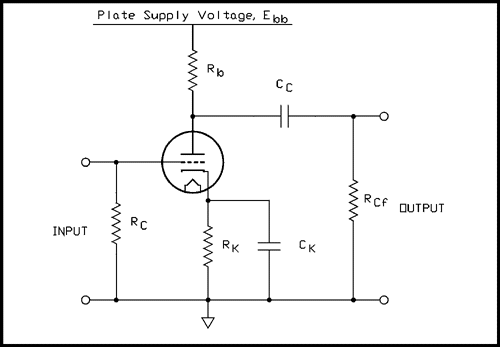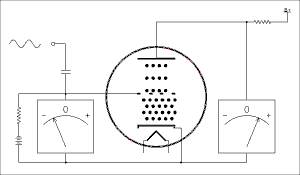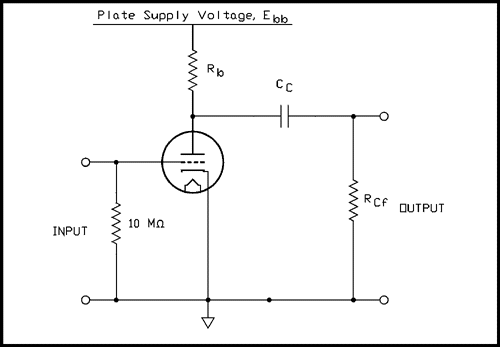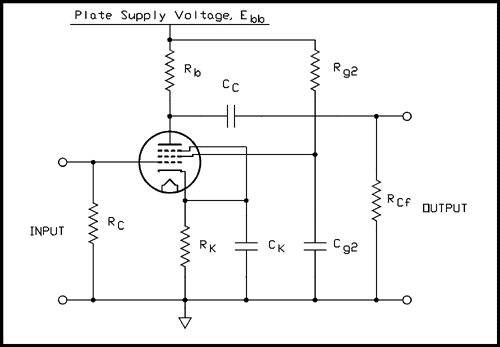With the exception of the power output, every stage in an audio amplifier is resistance coupled. For this reason it is absolutely imperative that you completely understand the workings of this kind of amplifier.The name derives from the fact that the plate circuit of the tube has a resistor in it. The output signal is developed across this resistor by the plate current flowing through it. (Note: The output stage is transformer coupled.) The circuit of a basic resistance coupled amplifier stage is shown below.
This stage may be driven by another resistance coupled amplifier stage in which case the resistor on the left labeled RC is RCf for the previous stage. The resistor on the right labeled RCf is the grid resistor of the next or following stage. 
For a verbal description click here.
The DC operating conditions.
The resistor labeled RC serves one purpose; that is to hold the grid at, or very near, ground potential. The cathode resistor Rk develops the negative voltage for the grid.A note about ground. The concept of ground is a result of human thinking and has nothing to do with the operation of the circuit. The tube doesn't know from ground it just does what it does. We humans can arbitrarily move the ground and the circuit won't care or even know.Electrons are flowing from the bottom end of the cathode resistor upwards. When they get inside the tube they are emitted from the cathode and flow to the plate where they are absorbed. They emerge from the tube and continue flowing upwards through the plate resistor and eventually reach the power supply where they are returned to the bottom line of the circuit. The upper end of each resistor is at a higher voltage than the lower end. It is also true to say that the lower end of each resistor is at a lower voltage than the upper end.Think of voltage or electrical potential as altitude. Up is up and down is down. Ground is sea level. Now in altitude we can't move sea level but we can decide where we want to measure altitude from. Let's say your front yard is 600 feet above sea level. The top of a bush has an altitude of 605 feet and the top of a tall tree has an altitude of 670 feet. You could give the same information by taking the front yard as zero altitude and the top of the bush would be at 5 feet and the top of the tree at 70 feet. And further more you could take the top of the bush as zero altitude and the surface of your front yard would be at -5 feet and the top of the tree would be at 65 feet. The actual altitude of your front yard, the top of the bush or the top of the tree didn't change during all of this thinking just the way we humans thought about it.
The last part of that example is particularly important. The top of the bush was at 0 altitude and the yard was at -5 feet. Now let's go back into the house and sit down in front of the computer again. Let's say the top end of the cathode resistor is at +1.5 volts. The grid will be at ground potential which is, by definition, 0 volts. But now let's move what we call zero. If we say the cathode is at 0 volts the bottom end of the cathode resistor will be at -1.5 volts. Now we have already established that the grid is at the same voltage as the bottom end of the cathode resistor. So, the grid is at -1.5 volts. This is how we can make the grid of a tube negative without having a negative power supply. This is often referred to as "self bias".
Why does the grid of a tube have to be negative? When the grid is at zero, and so is the cathode, the tube is conducting heavily. That is about as far as it can go. Any attempt to drive the grid positive will result in grid current and a vary low impedance source is required to make it go that way. (It should be noted that there are some applications, in radio transmitters, where this condition is used to obtain higher efficiency than would otherwise be possible.) In audio work the plate current must be able to go up and down from its steady value so we must set the grid somewhat negative so the current can move in either direction. When the grid is slightly negative it repels some of the electrons and not as many get through to the plate. As the grid is made more and more negative, fewer and fewer electrons get through and the plate current gets smaller and smaller. A point is finally reached where no electrons can get through and plate current is said to be cut off.The resistor in the plate returns the electrons to the power supply and converts any change in the tube's plate current into a change in voltage at the plate terminal.The AC Story
Now let's apply an AC signal to the grid of the tube. The AC voltage starts at zero, goes positive, reaches its peak value, and then returns to zero. But it isn't finished. It goes negative, reaches a negative peak and then returns to zero again. That's the definition of one cycle. The resting, or steady state voltage on the grid somewhat restricts the electron flow but does not turn it off. When the applied signal goes positive the electron current between cathode and plate (plate current) is increased. On the negative part of the cycle the plate current is decreased. So you can see that the plate current is increasing and decreasing in step with the input signal. This condition is known as "in phase".In my 33 years of teaching electronics I have tried many ways to explain this next part but I confess that I never tried it this way before. I'm sure that's because the activity of bungee jumping is relatively new. The plate supply voltage is the bridge, The plate resistor Rb is the bungee cord and the plate terminal of the tube is the jumper. In this case the bungee cord is not a spring but it's length depends on how much current is flowing through it. The greater the current the longer the cord. The hapless jumper is hanging there half way between the bridge and the ground. Then someone starts changing the current through the bungee cord. As the current increases the cord gets longer and the jumper gets closer to the ground. Then the current decreases, the cord gets shorter and the jumper rises up to be farther from ground. So as the current increases the jumper goes lower and as the current decreases the jumper goes higher.
The voltage across the resistor is the length of the bungee cord. As current increases, ohm's law tells us that voltage across the resistor gets grater but remember that's the length of the bungee cord. So when the plate current increases the voltage across the resistor increases (the bungee cord gets longer) and the voltage between the plate terminal and ground gets smaller (the jumper gets closer to ground. The plate voltage is doing the opposite thing as the plate current. Current increases, voltage decreases, current decreases, voltage increases. That condition is known as "out of phase". The animation below should help.
The above animation shows this. What we have established is that a common cathode amplifier inverts the signal. That's a good thing because it would be difficult to build phase inverters without this phenomenon; but I'm getting ahead of myself. 
For a verbal description click here.
The capacitor CC couples the AC signal to the grid of the next stage while blocking the DC which is on the plate. For DC a capacitor is exactly what it looks like, an open circuit. For AC it presents a reactance which is inversely proportional to frequency. If the capacitor has the right value (correct fraction of a farad) it will pass the entire audio band to the next stage.
The capacitor across the cathode resistor CK may be omitted in some designs. When it is present it prevents changes in cathode voltage caused by plate current which also flows through the cathode resistor. The variations will subtract from the net grid voltage and lower the gain of the amplifier. If maximum gain is desired the capacitor must be included. If it is intentionally left out the gain is lowered but so is the amount of distortion. Gain is fairly easy to come by and so a designer can give up some to get lower distortion. Many amplifier designs omit the cathode bypass capacitor, as it is called, to improve the performance of the amplifier. If the capacitor is missing the gain must be calculated using the tube parameters which can be looked up in a tube manual. For details of these calculations see Vacuum Triodes.
The Capacitor Values
If you look at the data for resistance coupled amplifiers in a tube manual you will find a different formula. These manuals were not written by high fidelity engineers. Did they cheat on their wives? I don't know, but they designed audio sections of all American five radios instead of high fidelity amplifiers. The formulas given here are for a low frequency limit of 20 cycles.CK = 1 / (10 x RK) Where capacitances are in farads and resistances are in ohms.and
CC = 1 / (10 x RCf)
The Resistor Values
The values for the resistors can be obtained from a tube manual. Most of them have a section in the back, often in the appendix, called "Resistance Coupled Amplifier Data". These charts contain data for many of the most popular tube types. Copyright law prevents me from reproducing these charts here.I had planned to post data for a few tubes which I was going to determine experimentally myself, scouts honor. I have found that my breadboard picks up too much hum to make accurate measurements possible. I'm going to have to build a dedicated chassis for collecting this data. Meanwhile, check on eBay for tube manuals. At any given time there seem to be plenty of them listed.
The Zero Bias Grounded Cathode Amplifier.
If the grid of a triode tube is connected to common through a large resistor, say ten million ohms, a negative voltage will build up on the grid. This is caused by electrons impacting on the grid wires and staying there giving the grid a negative charge. The grid wires are small but they are big enough that electrons accidentally run into them. The large resistor causes this charge to leak off very slowly and electrons are continuously hitting the grid so a steady DC voltage exists on the grid. This voltage is enough to bias the tube without a resistor in the cathode. Tubes such as the 12 SQ7 and 12AV6 have been specifically designed to be operated under these conditions. Sometimes this is referred to as "Grid Leak Bias". The voltage is difficult to measure because the input resistance of most DMMs and VTVMs is 10 Meg ohms. The only way to make a valid measurement is to disconnect the resistor and let the meter take its place. The diagram of this type of amplifier is shown below.The advantage of this circuit is that it has fewer components. The disadvantage is that the designer has less control over the plate current and voltage of the tube. 
For a verbal description click here.
The Pentode Amplifier.
There may be a need to use pentode tubes as RC amplifiers. Pentodes produce considerably more gain than a triode. They also are more complex than triodes. There is one more resistor and one more capacitor which means more parts to go wrong. The diagram of a pentode RC amplifier is shown below.Everything said about the triode amplifier applies to the pentode. The only difference is that there are two extra grids. The second grid is called the screen grid because it was originally added to the tube to provide electrostatic shielding between the control grid and the plate. It works but it introduces a new problem. At times the plate can be at a lower voltage than the screen grid. When this occurs, electrons actually leave the plate and head back to the screen grid. It's called secondary emission. It seems that the impact of electrons striking the plate is sufficient to knock loose electrons already there. In a triode this is no problem because there is nothing more positive than the plate and these secondary electrons eventually go back to the plate. In a tetrode, these secondary electrons headed off toward the screen grid thus subtracting significantly from the plate current. The tetrode was made a pentode by adding yet another grid called the suppressor. It is connected to the cathode, or sometimes to the circuit common, and it forces secondary electrons from the plate to go back where they belong. The grid wires are far apart as compared to other grids so it has little effect on the fast moving electrons on their way to the plate. 
For a verbal description click here.
The screen grid has to be held at a constant potential as the plate current changes due to the audio signal so the capacitor Cg2 prevents degeneration (reduction of the gain). The value of this capacitor can be calculated from the formula
Cg2 = 1 / (10 x Rg2) For a more detailed discussion of pentode tubes and why they are used click here.